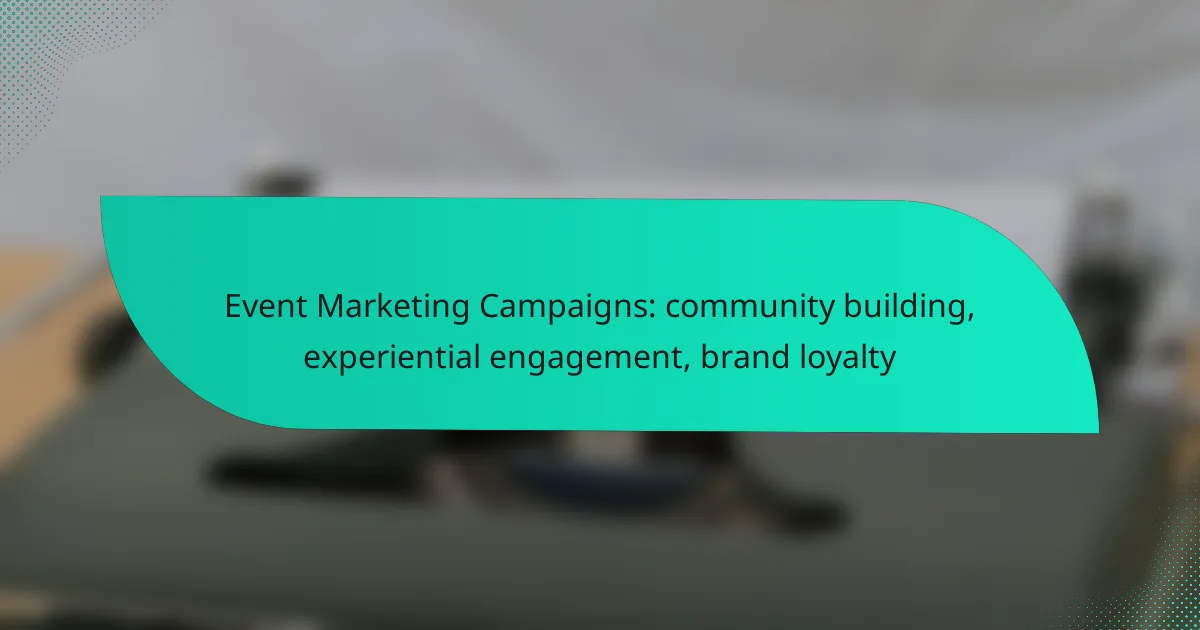Event marketing campaigns are a powerful tool for building community and fostering brand loyalty through shared experiences and local engagement. By implementing experiential engagement strategies, brands can create memorable interactions that deepen emotional connections with their audience. Success can be measured through various metrics, offering insights into attendee engagement and overall campaign effectiveness.
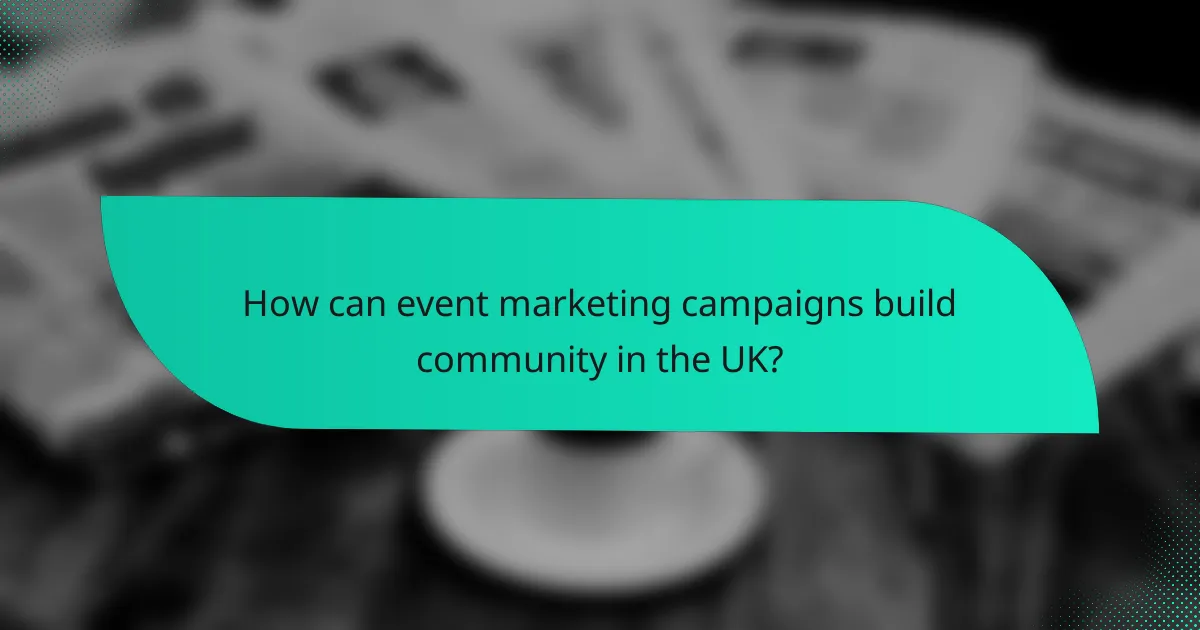
How can event marketing campaigns build community in the UK?
Event marketing campaigns can effectively build community in the UK by fostering connections among participants and creating shared experiences. By focusing on local engagement and interactive elements, brands can cultivate loyalty and a sense of belonging within their target audience.
Utilizing local partnerships
Building partnerships with local businesses and organizations can enhance the reach and impact of event marketing campaigns. Collaborating with community stakeholders not only boosts credibility but also attracts a wider audience who may be loyal to those local entities.
Consider co-hosting events with local charities, artists, or businesses to create a more inclusive atmosphere. This approach can lead to cross-promotion, where both parties benefit from increased visibility and community goodwill.
Creating interactive experiences
Interactive experiences engage attendees and encourage participation, which is crucial for building community. Activities such as workshops, live demonstrations, or hands-on installations can create memorable moments that resonate with participants.
For example, a brand could set up a pop-up event where attendees can try products, participate in contests, or engage in creative activities. These experiences not only entertain but also foster connections among participants, enhancing community ties.
Leveraging social media engagement
Social media is a powerful tool for building community around event marketing campaigns. By encouraging attendees to share their experiences online, brands can amplify their reach and create a sense of belonging among participants.
Utilize specific event hashtags and encourage attendees to post photos and stories. This not only promotes the event but also allows individuals to connect with others who share similar interests, further solidifying community bonds.
Hosting community-focused events
Community-focused events, such as local fairs, festivals, or charity drives, can significantly strengthen community ties. These events should reflect the interests and values of the local population, ensuring they resonate with attendees.
When planning such events, consider incorporating local culture, food, and entertainment to create a welcoming atmosphere. This approach not only attracts participants but also fosters a sense of pride and loyalty within the community, reinforcing the brand’s commitment to local engagement.
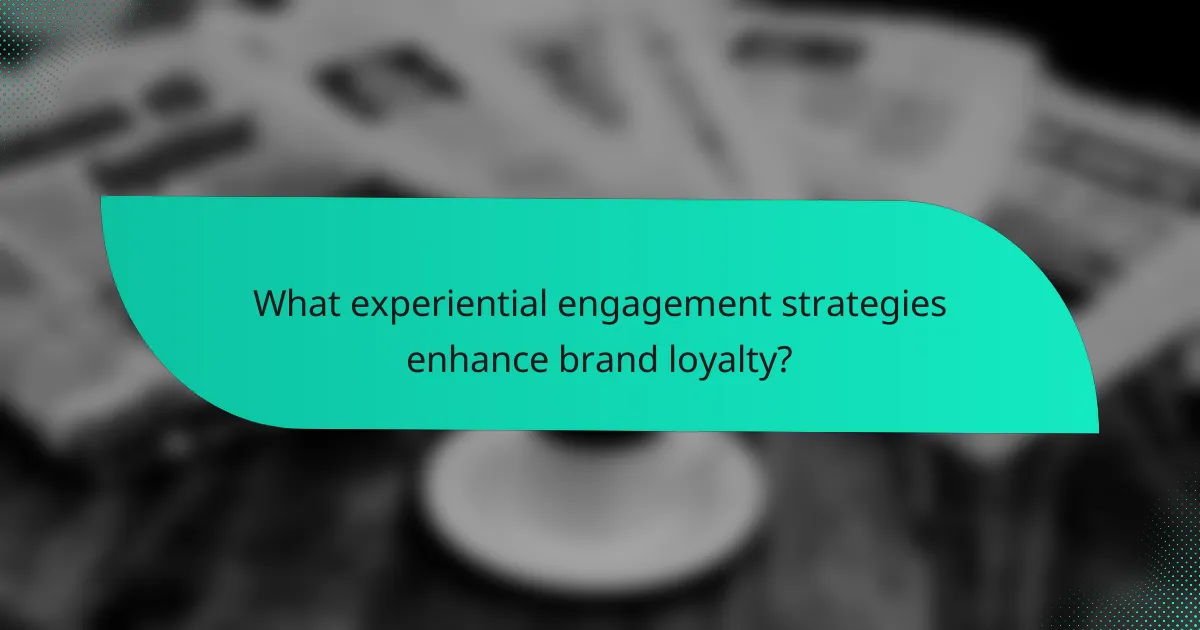
What experiential engagement strategies enhance brand loyalty?
Experiential engagement strategies that enhance brand loyalty focus on creating memorable interactions between the brand and its audience. These strategies foster emotional connections, encouraging customers to remain loyal and advocate for the brand.
Immersive brand experiences
Immersive brand experiences involve engaging customers in a way that fully captures their attention and emotions. This can include interactive installations, virtual reality experiences, or live events that allow attendees to experience the brand in a unique setting. For instance, a beverage company might host a pop-up event where participants can create their own drink flavors, enhancing their connection to the brand.
To implement immersive experiences, consider the venue, the sensory elements involved, and how to encourage participation. Ensure that the experience aligns with your brand values and resonates with your target audience for maximum impact.
Personalized attendee interactions
Personalized attendee interactions tailor experiences to individual preferences and behaviors, making participants feel valued. This can be achieved through customized communication, targeted content, or unique offerings based on attendee data. For example, using registration data to send personalized agendas or recommendations can enhance the overall experience.
To maximize personalization, gather insights through surveys or social media engagement before the event. Use this information to create tailored experiences that resonate with attendees, fostering a deeper connection to your brand.
Feedback loops for continuous improvement
Feedback loops are essential for refining experiential engagement strategies and enhancing brand loyalty. Collecting feedback from attendees during and after events allows brands to understand what worked well and what needs improvement. This can be done through surveys, social media polls, or direct conversations.
Establish a system for analyzing feedback and implementing changes based on insights gathered. Regularly updating your strategies based on attendee input not only improves future events but also demonstrates to your audience that their opinions are valued, strengthening brand loyalty over time.

Which metrics measure the success of event marketing campaigns?
Success in event marketing campaigns can be gauged through various metrics that reflect attendee interaction, brand perception, and financial outcomes. Key metrics include attendee engagement rates, brand sentiment analysis, and return on investment (ROI), each providing insights into different aspects of the campaign’s effectiveness.
Attendee engagement rates
Attendee engagement rates measure how actively participants interact with your event. This can include metrics such as session attendance, participation in activities, and social media interactions. High engagement rates often indicate that the event resonated well with the audience.
To assess engagement, consider tracking the number of questions asked during sessions, the frequency of social media posts tagged with your event hashtag, and feedback collected through surveys. Aim for engagement rates above 50% for a successful event.
Brand sentiment analysis
Brand sentiment analysis evaluates how attendees feel about your brand before, during, and after the event. This can be measured through surveys, social media monitoring, and online reviews. Positive sentiment can enhance brand loyalty and attract new customers.
Utilize tools that analyze social media mentions and sentiment scores to gauge attendee perceptions. A strong positive sentiment score, typically above 70%, suggests that your event successfully fostered a favorable brand image.
Return on investment (ROI)
Return on investment (ROI) quantifies the financial effectiveness of your event marketing campaign. It is calculated by comparing the revenue generated from the event against the total costs incurred. A positive ROI indicates that the event was financially beneficial.
To calculate ROI, use the formula: (Revenue – Costs) / Costs x 100. Aim for an ROI of at least 20% to consider the event a financial success. Keep in mind that while direct sales are important, also factor in long-term brand benefits and customer relationships when assessing overall success.
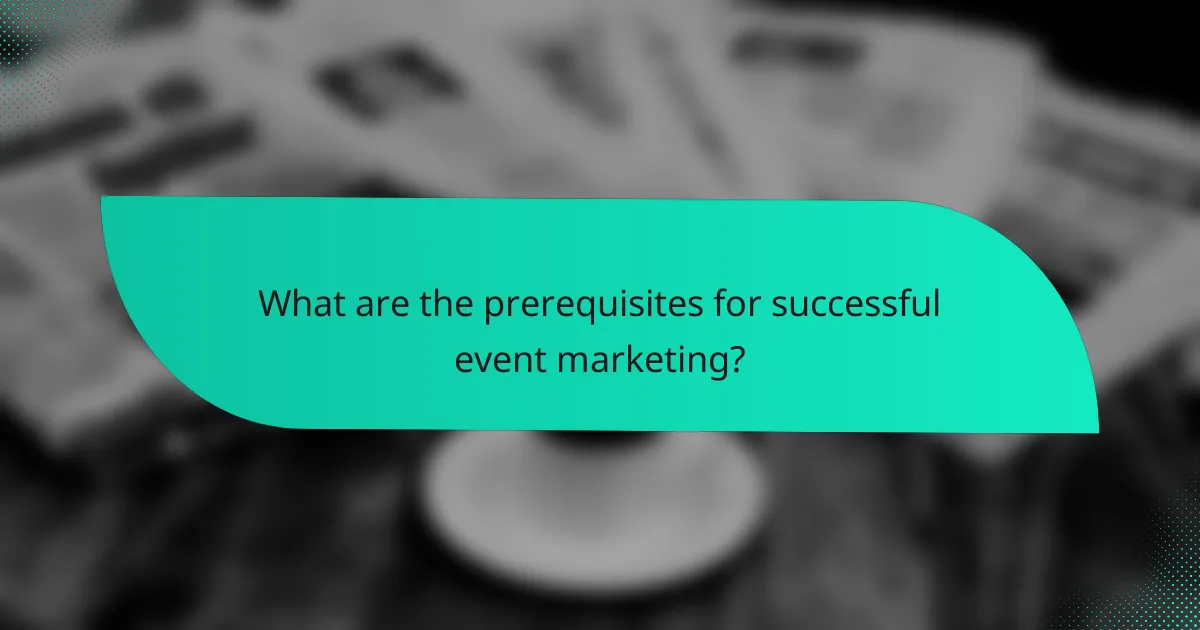
What are the prerequisites for successful event marketing?
Successful event marketing requires clear objectives and a well-defined target audience. These elements ensure that the campaign is focused and effective in building community, engaging participants, and fostering brand loyalty.
Clear campaign objectives
Establishing clear campaign objectives is essential for guiding your event marketing strategy. Objectives should be specific, measurable, achievable, relevant, and time-bound (SMART). For example, you might aim to increase brand awareness by 20% within six months following the event.
Consider what you want to achieve: Is it generating leads, enhancing customer relationships, or promoting a new product? Aligning your objectives with your overall business goals will help you measure success and adjust strategies as needed.
Target audience identification
Identifying your target audience is crucial for tailoring your event marketing efforts. Understand who your ideal participants are by analyzing demographics, interests, and behaviors. This can include factors such as age, location, and purchasing habits.
Utilize surveys, social media insights, and customer feedback to gather data on your audience. Creating detailed buyer personas can help you visualize and address the needs of your target market, ensuring your event resonates with them and encourages participation.
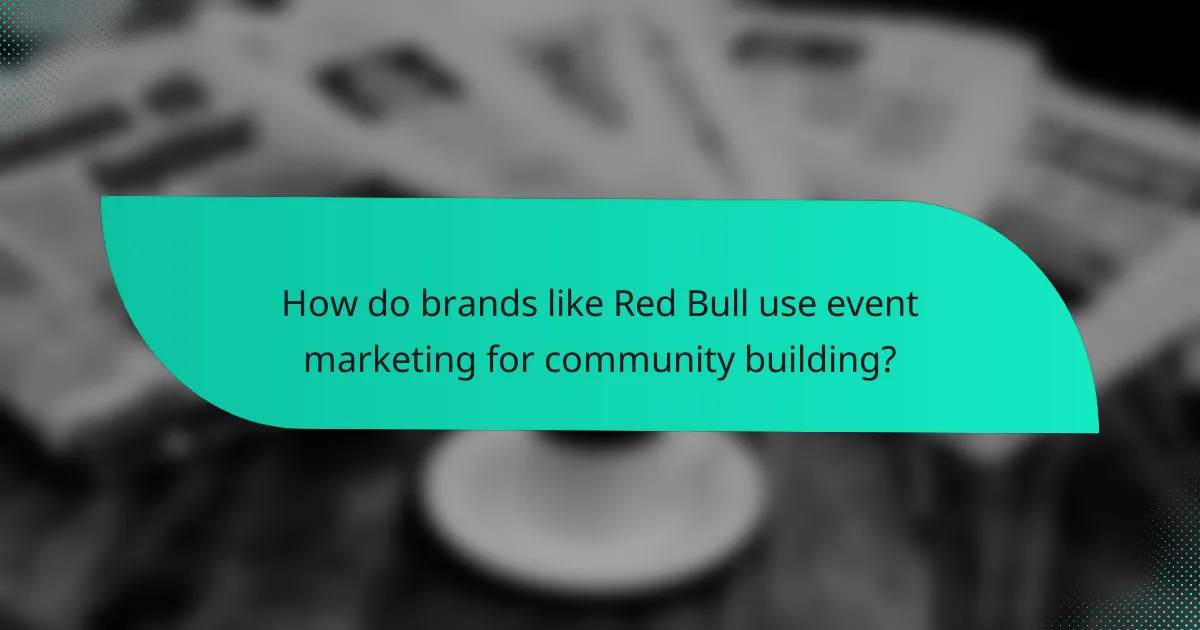
How do brands like Red Bull use event marketing for community building?
Brands like Red Bull leverage event marketing to foster community building by creating immersive experiences that resonate with their target audience. These events not only engage participants but also strengthen brand loyalty through shared experiences and memorable interactions.
Extreme sports sponsorships
Red Bull is renowned for sponsoring extreme sports events, which align perfectly with its brand image of adventure and adrenaline. By hosting competitions like the Red Bull Cliff Diving World Series, the brand cultivates a dedicated community of extreme sports enthusiasts who identify with its values.
These sponsorships often include interactive elements, such as athlete meet-and-greets and fan zones, enhancing engagement. Brands should consider the demographics of their audience when selecting sports to sponsor, ensuring alignment with brand identity and community interests.
Local music festivals
Local music festivals provide another avenue for Red Bull to connect with communities. By sponsoring or hosting stages at these events, the brand taps into local culture and music scenes, creating a sense of belonging among attendees. This approach not only promotes the brand but also supports local artists and communities.
To maximize impact, brands should tailor their involvement to reflect local tastes and preferences. Engaging with local influencers and artists can further enhance authenticity and deepen community ties, making the brand a recognized part of the local experience.
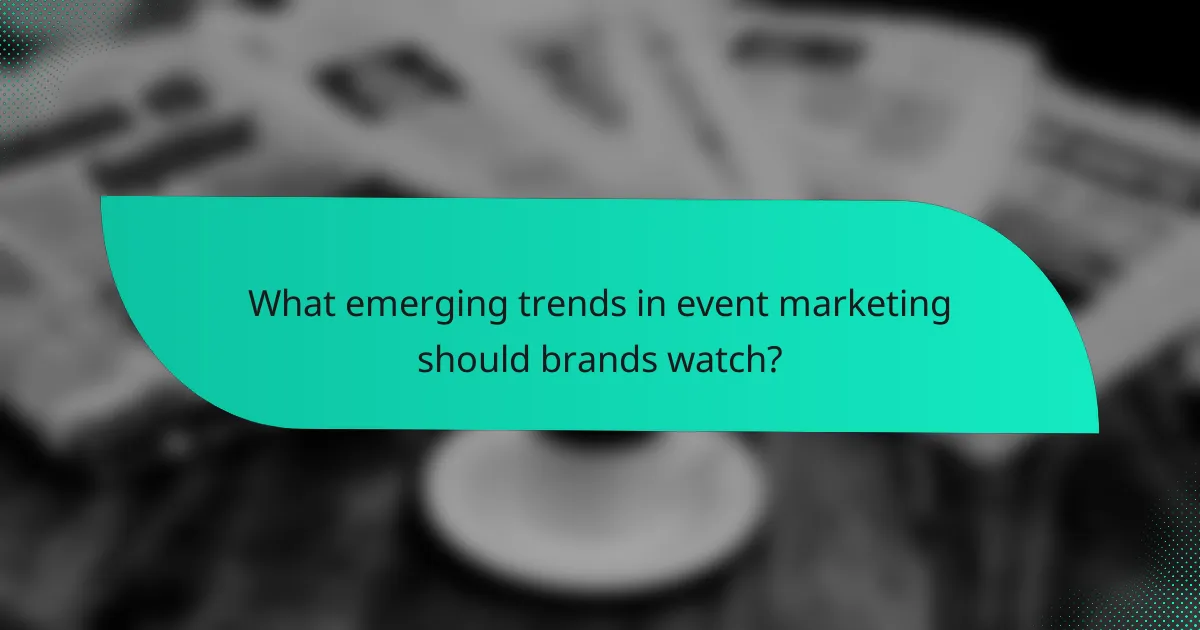
What emerging trends in event marketing should brands watch?
Brands should pay attention to trends in community building, experiential engagement, and brand loyalty as they shape the future of event marketing. These trends emphasize creating meaningful connections with audiences through immersive experiences and fostering long-term relationships.
Community Building
Community building in event marketing focuses on creating a sense of belonging among attendees. Brands can achieve this by facilitating networking opportunities, encouraging user-generated content, and leveraging social media platforms to keep the conversation going beyond the event.
For instance, brands can host pre-event meetups or online forums to engage potential attendees. Post-event follow-ups, such as surveys or exclusive content, help maintain the community and encourage ongoing interaction.
Experiential Engagement
Experiential engagement involves creating memorable, interactive experiences that resonate with attendees. This can include hands-on activities, immersive environments, or personalized interactions that allow participants to connect with the brand on a deeper level.
Examples include pop-up events, virtual reality experiences, or workshops that align with the brand’s values. Brands should focus on designing experiences that are relevant and appealing to their target audience to maximize impact.
Brand Loyalty
Building brand loyalty through event marketing requires consistent engagement and value delivery. Brands can cultivate loyalty by offering exclusive access, rewards programs, or personalized experiences that make attendees feel valued.
For example, loyalty programs that provide discounts or early access to future events can encourage repeat attendance. Brands should also gather feedback to continuously improve their offerings and strengthen customer relationships.
